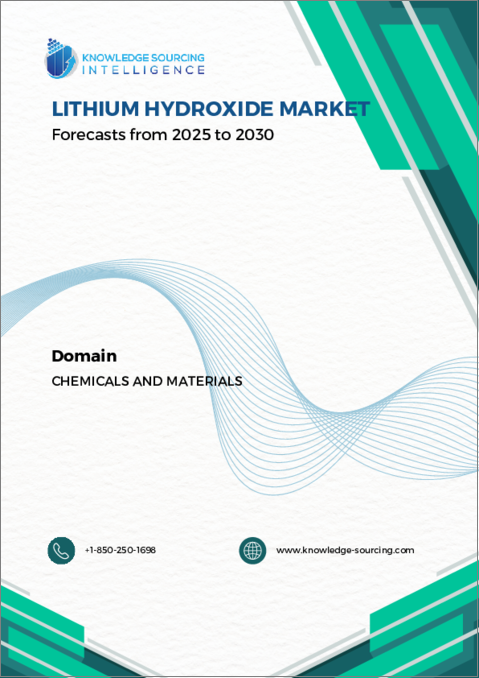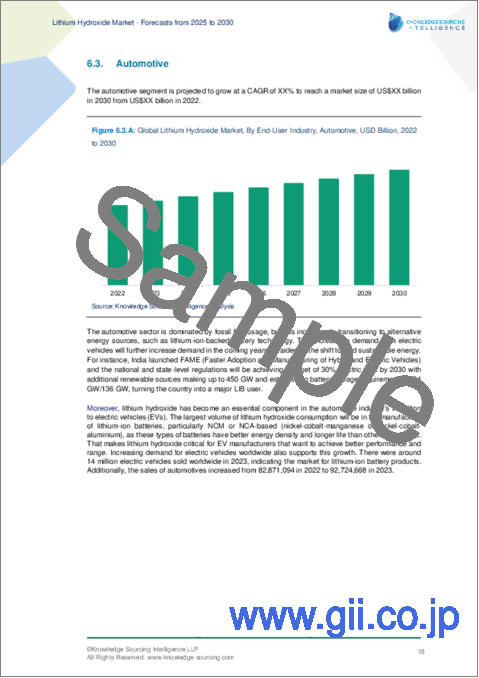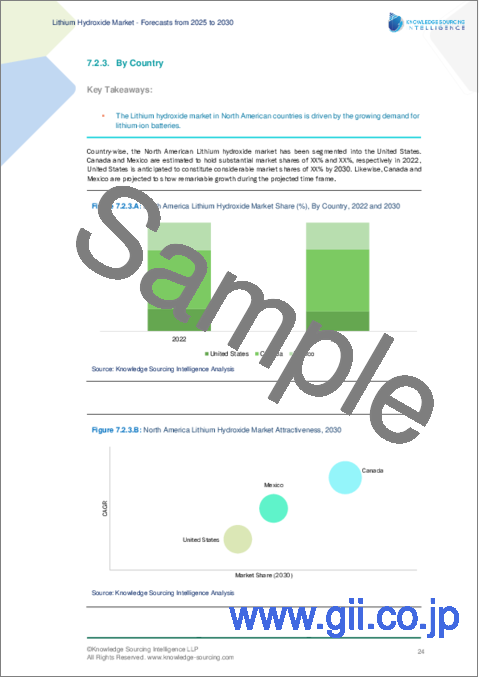|
|
市場調査レポート
商品コード
1627584
水酸化リチウムの世界市場:予測(2025年~2030年)Lithium Hydroxide Market - Forecasts from 2025 to 2030 |
||||||
カスタマイズ可能
|
|||||||
| 水酸化リチウムの世界市場:予測(2025年~2030年) |
|
出版日: 2024年12月20日
発行: Knowledge Sourcing Intelligence
ページ情報: 英文 140 Pages
納期: 即日から翌営業日
|
全表示
- 概要
- 目次
世界の水酸化リチウムの市場規模は、2025年の162億7,100万米ドルから2030年には256億500万米ドルに達し、CAGR9.49%で成長すると推定されています。
水酸化リチウムは無機化合物の一種であり、自動車、航空宇宙、電気・電子、海洋など様々な産業に応用されています。水酸化リチウムは、主に冷却剤のアルカリ化に利用されています。また、水酸化リチウム化合物は、様々な種類の不要なガスの吸収にも使用されます。
水酸化リチウムの世界の成長を促進している主な要因は、航空宇宙および海洋セクターの世界の生産量の増加です。水酸化リチウムは主に航空宇宙・海洋分野で炭酸リチウムの生産に使用されています。水酸化リチウム化合物は、空気中の二酸化炭素の除去にも役立っています。
航空宇宙分野の世界の生産量は、大きな伸びを示しました。航空宇宙産業の世界的リーダーであるエアバスは、同社が2023年に大きな成長を達成したと発表しました。同社によると、2023年に同社が納入した民間航空機は約735機で、約11%増加しました。同社によると、2023年に納入されたA220ファミリーは、2022年の53機から68機に増加しました。同様に、2023年には、A330ファミリーが約32機、A350ファミリーが約64機となり、A320ファミリーは合計571機となりました。
水酸化リチウム市場の成長促進要因:
- 電気自動車の生産台数増加
世界市場における電気自動車の生産台数の増加は、予測期間中の水酸化リチウム市場の成長を促進する主要な要因の一つです。世界の電気自動車生産において、水酸化リチウムは、電気自動車の動力源として使用されるリチウムイオン電池の各種正極材料の生産に主に使用されています。電気自動車では、水酸化リチウムの材料は、より高い密度と高い容量を確保するために使用されます。電気自動車において、水酸化リチウムは、他の正極材料と比較して複数の利点を提供します。水酸化リチウムは、バッテリーの安全性を高めると同時に、電気自動車用バッテリーの動作寿命と効率を高めます。また、水酸化リチウムは、より高い電池容量を提供します。
電気自動車の世界の需要は、ここ数年で大きく伸びています。国際エネルギー機関(IEA)の世界報告書によると、2021年の電気自動車の総販売台数は470万台で、2022年には730万台に増加しました。2023年には、世界市場における自動車の総生産台数は950万台を記録しました。同様に、世界市場における電気バンの販売台数は、2023年には46万台となり、2021年の17万台、2022年の31万台から急増しました。
同様に、国際エネルギー機関(IEA)はその報告書の中で、電気トラックの販売台数も過去数年間で大きく伸びたと述べています。同機関によると、2021年の世界市場における電気トラックの総販売台数は2万台で、2022年には3万9,000台に増加しました。2023年には、世界市場における電気トラックの総販売台数は5万3,000台を記録しました。
水酸化リチウム市場の地理的展望:
- 北米は水酸化リチウム市場で大きな成長が見込まれる
北米諸国の水酸化リチウム市場は、リチウムイオン電池の需要拡大が牽引しています。米国の市場は、リチウム市場の予測期間を通じて力強い後押しが期待されています。全地域の中でユニークなのは、厳しい規制規則による影響のため、グリーンエネルギー源の採用に強い推進力があることです。環境保護庁(EPA)からの補助金に関するオファーやプログラムを開始したパイオニアであり、太陽光、風力、地熱を含む代替ソースを使用するためのさまざまなスキームやプログラムは注目に値しますが、これらに限定されるものではありません。ソーラーパネルが普及するということは、蓄電池やバッテリーの需要が増えるということです。例えば、NASAのSabbaticalのように、航空機のガスエンジンはNASAが考案したLIBパックに置き換えられ、より多くの請負業者と協力するようになりました。さらに、連邦政府によるグリーン・エネルギー・プロジェクトや、EVの普及を促進するためのインフラ投資も、水酸化リチウムの需要を押し上げる方向にあります。再生可能エネルギーの利用が増加すれば、エネルギー貯蔵のための適切なシステムが必要となり、リチウムイオン電池の需要が増加します。米国の水酸化リチウム市場はここ数年変動していますが、全体的な意味では、電気輸送とエネルギー貯蔵技術の近代化により、急成長しているようです。
さらに、米国におけるリチウムイオン電池の需要拡大も市場需要を高めており、例えば、米国は主要EV市場の中で最も高い成長を記録し、前年比40%以上に達しました。米国は2023年には約100GWhの市場になります。さらに、米国の蓄電池容量は2021年から増加しており、開発者が商業運転開始日までに計画した蓄電システムをすべて完成させたと仮定すると、2024年末までに89%増加する可能性があります。開発者は、2024年末までに米国のバッテリー容量を30ギガワット(GW)以上に増やすつもりです。容量増加の大半は、風力発電と太陽光発電が急速に発展している2つの州からもたらされます。カリフォルニア州の蓄電池設置容量は7.3GWで、テキサス州(3.2GW)がこれに続きます。
本レポートを購入する理由
- 洞察に満ちた分析:顧客セグメント、政府政策と社会経済要因、消費者嗜好、業界、その他のサブセグメントに焦点を当て、主要地域および新興地域を網羅した詳細な市場考察を得ることができます。
- 競合情勢:世界の主要企業が採用している戦略的動きを理解し、適切な戦略による市場浸透の可能性を理解することができます。
- 市場動向と促進要因:ダイナミックな要因と極めて重要な市場動向、そしてそれらが今後の市場展開をどのように形成していくかを探ります。
- 実行可能な提言:ダイナミックな環境の中で、新たなビジネスストリームと収益を発掘するための戦略的意思決定に洞察を活用します。
- 幅広い利用者に対応:新興企業、研究機関、コンサルタント、中小企業、大企業にとって有益で費用対効果が高くなっています。
どのような用途で利用されているか?
業界および市場考察、事業機会評価、製品需要予測、市場参入戦略、地理的拡大、設備投資の決定、規制の枠組みと影響、新製品開発、競合の影響
調査範囲
- 2022年~2030年の実績データと予測
- 成長機会、課題、サプライチェーンの展望、規制枠組み、顧客行動、動向分析
- 競合のポジショニング、戦略、市場シェア分析
- セグメントと各国を含む地域の収益成長と予測分析
- 企業プロファイル(主に戦略、製品、財務情報、主要な発展など)
目次
第1章 イントロダクション
- 市場概要
- 市場の定義
- 調査範囲
- 市場セグメンテーション
- 通貨
- 前提条件
- 基準年と予測年のタイムライン
- 利害関係者にとっての主なメリット
第2章 調査手法
- 調査デザイン
- 調査プロセス
第3章 エグゼクティブサマリー
- 主な調査結果
第4章 市場力学
- 市場促進要因
- 市場抑制要因
- ポーターのファイブフォース分析
- 業界バリューチェーン分析
- アナリストの見解
第5章 水酸化リチウム市場:用途別
- イントロダクション
- 潤滑グリース
- 精製
- バッテリー
- ガラス・セラミック
- その他
第6章 水酸化リチウム市場:最終用途産業別
- イントロダクション
- 輸送
- 自動車
- 海洋
- 航空宇宙
- 電気・電子
- その他
第7章 水酸化リチウム市場:地域別
- イントロダクション
- 北米
- 用途別
- 最終用途産業別
- 国別
- 南米
- 用途別
- 最終用途産業別
- 国別
- 欧州
- 用途別
- 最終用途産業別
- 国別
- 中東・アフリカ
- 用途別
- 最終用途産業別
- 国別
- アジア太平洋
- 用途別
- 最終用途産業別
- 国別
第8章 競合環境と分析
- 主要企業と戦略分析
- 市場シェア分析
- 合併・買収・協定・協業
- 競合ダッシュボード
第9章 企業プロファイル
- Albemarle Corporation
- Honeywell
- AG Chemi Group
- Sigma Aldrich
- Merck KGaA
- Pq Corporation
- Carl Roth
- Leverton lithium
- Ennore India Chemicals International
- Ganfeng Lithium
- Sihauli Chemicals Private Limited
- Uma Chemicals
- Vishnupriya Chemicals Pvt. Ltd
The lithium hydroxide market is estimated to reach US$25.605 billion by 2030 from US$16.271 billion in 2025, growing at a CAGR of 9.49%.
Lithium hydroxide is a type of inorganic compound, that offers its application across multiple industries including automotive, aerospace, electrical & electronics, and marine among others. Lithium hydroxide is majorly utilized for reacting coolants alkalizing. Lithium hydroxide compound is also used in absorbing various types of unwanted gases.
The major factor propelling the growth of global lithium hydroxide is the increasing global production of the aerospace and marine sectors. In the aerospace and marine sectors, lithium hydroxide is mainly used to produce lithium carbonate. The lithium hydroxide compound also helps in removing carbon dioxide from the air.
The global production of the aerospace sector witnessed major growth. Airbus, a global leader in the aerospace industry, announced that the company witnessed massive growth in 2023. The company stated that in 2023, the company delivered about 735 commercial aircraft, which observed an increase of about 11%. The company stated that in 2023, the delivery of its A220 family of aircraft increased to 68 from 53 in 2022. Similarly, in 2023, about 32 and 64 A330 families and A350 families respectively were recorded, whereas a total of 571 A320 family of aircraft were delivered by the company.
Lithium hydroxide market growth drivers:
- Rising production of electric vehicles
The rising production of electric vehicles across the global market is among the major factors propelling the growth of the lithium hydroxide market during the forecasted timeline. In global electric vehicle production, lithium hydroxide is majorly used for the production of various types of cathode material of the lithium-ion battery, which is used to power electric vehicles. In the electric vehicles, the lithium hydroxide material is used to ensure a higher density and higher capacity. In electric vehicles, lithium hydroxide offers multiple benefits compared to other types of cathode materials. Lithium hydroxide helps enhance the safety of the battery and simultaneously enhances the operational life and efficiencies of electric vehicle batteries. The lithium hydroxide also offers a higher battery capacity.
The global demand for electric vehicles witnessed significant growth over the past few years. The International Energy Agency, in its global report, stated that in 2021, the total sale of electric vehicles stated that a total of 4.7 million battery electric vehicles was recorded, which increased to 7.3 million in 2022. In 2023, the total production of cars in the global market was recorded at 9.5 million. Similarly, the sales of electric vans in the global market were recorded at 460,000 in 2023, which surged from 170,000 in 2021, and 310,000 in 2022.
Similarly, the International Energy Agency, in its report further stated that the sales of electric trucks also witnessed a major growth during the past few years. The agency stated that in 2021, the total sales of electric trucks in the global market were recorded at 20,000, which increased to 39,000 in 2022. In 2023, the total sales of electric trucks in the global market were recorded at 53,000 units.
Lithium hydroxide market geographical outlook:
- The North American region is expected to witness significant growth in the lithium hydroxide market.
The Lithium hydroxide market in North American countries is driven by the growing demand for lithium-ion batteries. The market in the United States has a strong boost expected through its lithium market forecast period. Uniquely among all regions, it has a strong impetus for the adoption of green energy sources due to discrimination by tight regulatory rules. Being a pioneer in initiating offers and programs on grants from the Environmental Protection Agency (EPA), it's worth noting the different schemes and programs for using alternatives of sources that include solar, wind, geothermal, and not limited to these. More popular solar panel means more demand for energy storage cells and batteries. For instance, Sabbatical from NASA; gas-powered engines of aircraft were replaced by LIB packs devised by NASA and collaborated with more contractors. Moreover, the growing emphasis on federal green energy projects as well as infrastructural investments to catalyze the adoption of EVs are geared toward pushing demand for lithium hydroxide higher. Increased renewable energy use would otherwise require appropriate systems for energy storage, hence increasing demand for lithium-ion batteries. The lithium hydroxide market in the United States has fluctuated over the last few years but, in an overall sense, seems to be surging at an increasing pace because of modernization in electric transportation and energy storage technologies.
Further, the growing demand for lithium-ion batteries in the United States is also increasing the market demand, for instance, the United States recorded the highest growth among major EV markets, reaching more than 40% year on year. The United States is the market, with around 100 GWh in 2023. Moreover, battery storage capacity in the United States has been increasing since 2021, and it might climb by 89% by the end of 2024 assuming developers complete all of the energy storage systems they have planned by the commercial operation dates. Developers intend to increase U.S. battery capacity to more than 30 gigawatts (GW) by the end of 2024. The majority of capacity additions come from two states with fast-developing wind and solar generation fleets. California has the highest installed battery storage capacity of any state, at 7.3 GW, followed by Texas (3.2 GW).
Reasons for buying this report:-
- Insightful Analysis: Gain detailed market insights covering major as well as emerging geographical regions, focusing on customer segments, government policies and socio-economic factors, consumer preferences, industry verticals, other sub- segments.
- Competitive Landscape: Understand the strategic maneuvers employed by key players globally to understand possible market penetration with the correct strategy.
- Market Drivers & Future Trends: Explore the dynamic factors and pivotal market trends and how they will shape up future market developments.
- Actionable Recommendations: Utilize the insights to exercise strategic decision to uncover new business streams and revenues in a dynamic environment.
- Caters to a Wide Audience: Beneficial and cost-effective for startups, research institutions, consultants, SMEs, and large enterprises.
What do businesses use our reports for?
Industry and Market Insights, Opportunity Assessment, Product Demand Forecasting, Market Entry Strategy, Geographical Expansion, Capital Investment Decisions, Regulatory Framework & Implications, New Product Development, Competitive Intelligence
Report Coverage:
- Historical data & forecasts from 2022 to 2030
- Growth Opportunities, Challenges, Supply Chain Outlook, Regulatory Framework, Customer Behaviour, and Trend Analysis
- Competitive Positioning, Strategies, and Market Share Analysis
- Revenue Growth and Forecast Assessment of segments and regions including countries
- Company Profiling (Strategies, Products, Financial Information, and Key Developments among others)
The lithium hydroxide Market is analyzed into the following segments:
By Application
- Lubricating Greases
- Purification
- Batteries
- Glass & Ceramics
- Others
By End-User Industry
- Transportation
- Automotive
- Marine
- Aerospace
- Electrical & Electronics
- Others
By Geography
- North America
- United States
- Canada
- Mexico
- South America
- Brazil
- Argentina
- Others
- Europe
- United Kingdom
- Germany
- France
- Italy
- Spain
- Others
- Middle East and Africa
- Saudi Arabia
- UAE
- Others
- Asia Pacific Region
- China
- Japan
- South Korea
- India
- Indonesia
- Thailand
- Taiwan
- Others
TABLE OF CONTENTS
1. INTRODUCTION
- 1.1. Market Overview
- 1.2. Market Definition
- 1.3. Scope of the Study
- 1.4. Market Segmentation
- 1.5. Currency
- 1.6. Assumptions
- 1.7. Base and Forecast Years Timeline
- 1.8. Key benefits for the stakeholders
2. RESEARCH METHODOLOGY
- 2.1. Research Design
- 2.2. Research Process
3. EXECUTIVE SUMMARY
- 3.1. Key Findings
4. MARKET DYNAMICS
- 4.1. Market Drivers
- 4.2. Market Restraints
- 4.3. Porter's Five Forces Analysis
- 4.3.1. Bargaining Power of Suppliers
- 4.3.2. Bargaining Power of Buyers
- 4.3.3. The Threat of New Entrants
- 4.3.4. Threat of Substitutes
- 4.3.5. Competitive Rivalry in the Industry
- 4.4. Industry Value Chain Analysis
- 4.5. Analyst View
5. LITHIUM HYDROXIDE MARKET BY APPLICATION
- 5.1. Introduction
- 5.2. Lubricating Greases
- 5.3. Purification
- 5.4. Batteries
- 5.5. Glass & Ceramics
- 5.6. Others
6. LITHIUM HYDROXIDE MARKET BY END-USER INDUSTRY
- 6.1. Introduction
- 6.2. Transportation
- 6.3. Automotive
- 6.4. Marine
- 6.5. Aerospace
- 6.6. Electrical & Electronics
- 6.7. Others
7. LITHIUM HYDROXIDE MARKET BY GEOGRAPHY
- 7.1. Introduction
- 7.2. North America
- 7.2.1. By Application
- 7.2.2. By End-User Industry
- 7.2.3. By Country
- 7.2.3.1. United States
- 7.2.3.2. Canada
- 7.2.3.3. Mexico
- 7.3. South America
- 7.3.1. By Application
- 7.3.2. By End-User Industry
- 7.3.3. By Country
- 7.3.3.1. Brazil
- 7.3.3.2. Argentina
- 7.3.3.3. Others
- 7.4. Europe
- 7.4.1. By Application
- 7.4.2. By End-User Industry
- 7.4.3. By Country
- 7.4.3.1. United Kingdom
- 7.4.3.2. France
- 7.4.3.3. Germany
- 7.4.3.4. Italy
- 7.4.3.5. Spain
- 7.4.3.6. Others
- 7.5. Middle East and Africa
- 7.5.1. By Application
- 7.5.2. By End-User Industry
- 7.5.3. By Country
- 7.5.3.1. Saudi Arabia
- 7.5.3.2. UAE
- 7.5.3.3. Others
- 7.6. Asia Pacific
- 7.6.1. By Application
- 7.6.2. By End-User Industry
- 7.6.3. By Country
- 7.6.3.1. China
- 7.6.3.2. Japan
- 7.6.3.3. South Korea
- 7.6.3.4. India
- 7.6.3.5. Indonesia
- 7.6.3.6. Thailand
- 7.6.3.7. Taiwan
- 7.6.3.8. Others
8. COMPETITIVE ENVIRONMENT AND ANALYSIS
- 8.1. Major Players and Strategy Analysis
- 8.2. Market Share Analysis
- 8.3. Mergers, Acquisitions, Agreements, and Collaborations
- 8.4. Competitive Dashboard
9. COMPANY PROFILES
- 9.1. Albemarle Corporation
- 9.2. Honeywell
- 9.3. AG Chemi Group
- 9.4. Sigma Aldrich
- 9.5. Merck KGaA
- 9.6. Pq Corporation
- 9.7. Carl Roth
- 9.8. Leverton lithium
- 9.9. Ennore India Chemicals International
- 9.10. Ganfeng Lithium
- 9.11. Sihauli Chemicals Private Limited
- 9.12. Uma Chemicals
- 9.13. Vishnupriya Chemicals Pvt. Ltd





